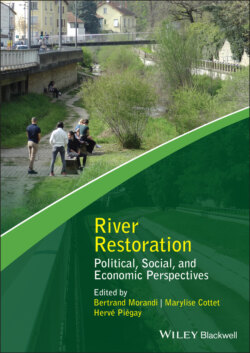Читать книгу River Restoration - Группа авторов - Страница 2
Table of Contents
Оглавление1 Cover
2 Title Page
3 Copyright Page
4 Series Foreword
5 Acknowledgments
6 List of Contributors
7 Part I: Introduction 1 What are the Political, Social, and Economic Issues in River Restoration? Genealogy and Current Research Issues 1.1 Introduction 1.2 Genealogy of research on societal issues in river restoration 1.3 A scientific community organized regionally and occasionally around river restoration projects 1.4 A research field tackling several topics 1.5 A diversity of researchers’ positions with regard to operational action 1.6 A book to share a diversity of societal approaches in the field of river restoration References
8 Part II: People–River Relationships: From Ethics to Politics 2 Ethics of River Restoration 2.1 Introduction 2.2 Three challenges of river restoration 2.3 Restoration ecology as a type of biomimicry 2.4 Conclusions References 3 Restoring Sociocultural Relationships with Rivers 3.1 Introduction 3.2 What is river restoration? 3.3 Placing river restoration in its biophysical and sociocultural contexts 3.4 Emerging approaches to knowing and valuing rivers differently in Aotearoa New Zealand 3.5 Conclusions Acknowledgments References 4 Political Ecology and River Restoration 4.1 Introduction 4.2 Political ecology: A critical approach to environmental issues 4.3 Political ecology and river restoration 4.4 Restoring the ecological continuity of rivers: Controversies involving different meanings of the river 4.5 Conclusions: What does political ecology have to offer river restoration? References
9 Part III: Governance and Power Relationships Between Stakeholders 5 The Policy and Social Dimension of Restoration Thinking 5.1 Introduction 5.2 River restoration and the importance of interdependencies between public policies and between public and private rights 5.3 River restoration and interdependencies in territorial construction 5.4 River restoration and interdependencies of sciences and knowledge forms 5.5 Conclusions References 6 From Public Policies to Projects 6.1 Introduction 6.2 Toward a multifunctional, ecosystem‐based paradigm for river restoration 6.3 Political factors that determine river restoration 6.4 Field‐testing the river restoration new paradigm: from operation acceptance to rejection 6.5 Conclusions References 7 How to Better Involve Stakeholders in River Restoration Projects 7.1 Introduction 7.2 The role of stakeholders in dam removal in two different institutional contexts 7.3 From the involvement of the stakeholders to the enrichment of the project 7.4 Some key points to improve stakeholders’ involvement 7.5 Conclusions References 8 Letting the Political Dimension of Participation in River Restoration have its Space 8.1 Introduction 8.2 Participation and river restorations 8.3 Participation in Swiss river management 8.4 Processes of depoliticization at work 8.5 Recommendations for taking into account the political dimension of participation 8.6 Conclusions References
10 Part IV: Evaluation of Socioeconomic Effects 9 What is the Total Economic Value of River Restoration and Why is it Important? 9.1 Introduction 9.2 Defining and valuing the total economic value of river restoration 9.3 Estimation and application of river restoration total economic value 9.4 Conclusions 10 Valuation of Ecosystem Services to Assess River Restoration Projects 10.1 Introduction 10.2 Analytical framework of ecosystem services valuation 10.3 Case studies of ecosystem services valuations in river restoration project assessments 10.4 Case studies analysis: valuation of ES for assessing river restoration projects 10.5 Conclusions Acknowledgments 11 Public Perspectives of River Restoration Projects 11.1 Introduction 11.2 Theoretical foundations of public perspectives 11.3 Two empirical examples of how to include residents’ perspectives 11.4 Conclusions and Implications Acknowledgments References
11 Part V: Diversity of Methods, Diversity of Knowledge 12 Social Surveys 12.1 Introduction 12.2 Survey methods for studying the social dimensions of river restoration 12.3 Choosing between interviews and questionnaires for river restoration surveys 12.4 Conclusions 13 Documents on River Restoration 13.1 Introduction 13.2 What kind of documentary material can be used for what purpose? 13.3 What are the methods of documentary analysis and what results do they produce? 13.4 When to use a documentary approach? The pros and cons compared to survey methods 13.5 Conclusions 14 Participatory Approaches 14.1 Introduction 14.2 What are good practice principles for participatory river restoration? 14.3 What methods could be used for participatory river restoration? 14.4 Conclusions References 15 Economic Benefits 15.1 Introduction 15.2 Main phases of a valuation study and points of attention 15.3 Conclusions References
12 Part VI: Conclusions 16 Social, Economic, and Political Stakes of River Restoration 16.1 Humanities and social sciences now fully engaged within the field of restoration 16.2 Analysis of people–river relationships: from ethics to politics 16.3 Understanding of governance and power relationships between stakeholders 16.4 Evaluation of socioeconomic effects of river restoration projects 16.5 Strengthening collaborations between HSS and restoration stakeholders References
13 Index
14 End User License Agreement
